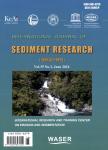Bedform development and its effect on bed stabilization and sediment transport based on a flume experiment with non-uniform sediment
Bedform development and its effect on bed stabilization and sediment transport based on a flume experiment with non-uniform sediment作者机构:Department of Soil and Water Conservation National Chung Hsing University Sinotech Engineering Consultants LTD. Department of Agricultural and Environmental Engineering Faculty of Agriculture and Life Science Hirosaki University
出 版 物:《International Journal of Sediment Research》 (国际泥沙研究(英文版))
年 卷 期:2017年第32卷第3期
页 面:305-312页
核心收录:
学科分类:0709[理学-地质学] 0819[工学-矿业工程] 08[工学] 0708[理学-地球物理学] 0818[工学-地质资源与地质工程] 0903[农学-农业资源与环境] 081502[工学-水力学及河流动力学] 0815[工学-水利工程] 0816[工学-测绘科学与技术]
主 题:Bedform development Bed stabilization Sediment transport Non-uniform bed
摘 要:Non-uniform sediment deposited in a confined, steep mountain channel can alter the bed surface composition. This study evaluates the contribution of geometric and resistance parameters to bed stabilization and the reduction in sediment transport. Flume experiments were done under various hydraulic conditions with non-uniform bed material and no sediment supply from upstream. Results indicate that flume channels respond in a sequence of coarsening and with the formation of bedformroughness features such as rapids, cascades, and steps. A bedform development coefficient is introduced and is shown to increase(i.e. vertical sinuosity develops) in response to increasing shear stress during the organization process. The bedform development coefficient also is positively correlated with the critical Shields number and Manning’s roughness coefficient, suggesting the evolution of flow resistance with increasing bedform development. The sediment transport rate decreases with increasing bed shear stress and bedform development, further illustrating the effect of bed stabilization. An empirical sediment transport model for an equilibrium condition is proposed that uses the bedform development coefficient, relative particle submergence(i.e. the ratio of mean water depth and maximum sediment diameter), modified bed slope, and discharge. The model suggests bedform development can play a primary role in reducing sediment transport(increasing bed stabilization). The model is an extension of Lane’s(1955) relation specifically adapted for mountain streams. These results explain the significance of bedform development in heightening flow resistance, stabilizing the bed, and reducing sediment transport in coarse, steep channels.



